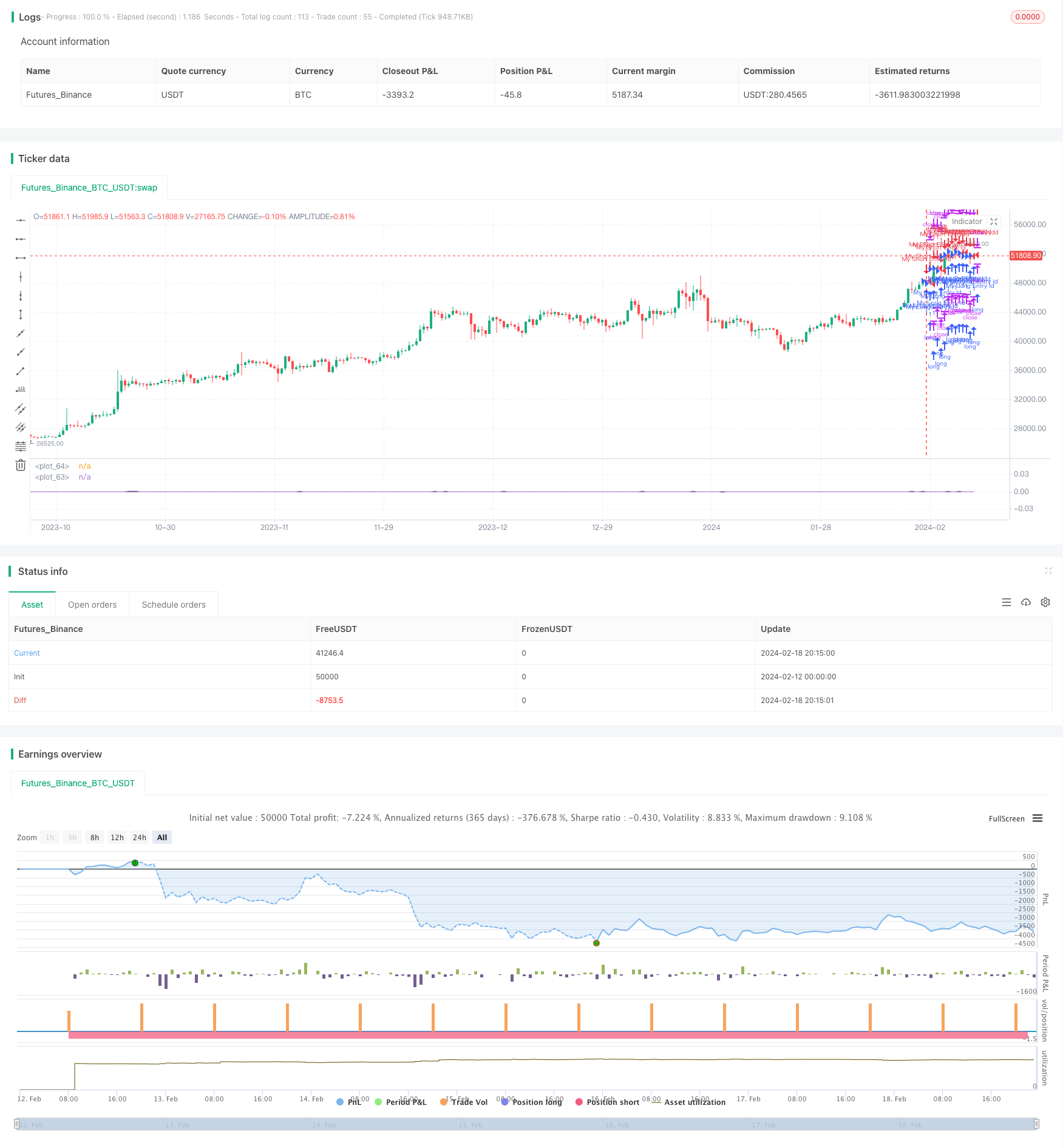
概述
该策略通过计算不同周期的均线和方差,来判断价格的趋势和波动性,实现对高点和低点的识别。
策略原理
该策略的核心逻辑是计算近期不同周期的均线和方差。具体来说,分别计算最近5日、4日和3日的均线(ma,mb,mc)和方差(da,db,dc)。然后比较大小,选择方差最大的一个周期代表当前趋势。最后,用代表趋势的周期的均线乘以其方差的平方,作为最终输出的曲线wg。
这样,当价格出现向上突破或向下突破时,代表趋势的周期和方差会发生较大变化。从而使得最终输出的wg也产生较大变化,实现对高点和低点的识别。
优势分析
这种基于不同周期判断趋势变化的思路行之有效,可以清楚地识别出价格的转折点。相比单一周期判断,这种组合多个周期的方法可以提高判断的准确性和及时性。
计算均线和方差也非常简单有效,代码量不大,且对突发的价格变化非常敏感,从而可以快速发现突破。
风险分析
该策略中使用的周期较短,对于中长线而言,判断可能不够准确和全面。短期内的价格震荡可能导致误判。
此外,均线和方差的权重设置也会影响判断效果,如果权重设置不当,则信号可能偏差。
优化方向
可以尝试加入更多不同周期的计算,组成周期组合,使判断更全面。比如加入 10 日、20 日等中长期周期判断。
也可以试验不同的权重设置方案,提高权重设定的灵活性。加入参数优化,使权重可以根据市场环境自动调整,减少误判概率。
此外,还可以结合其他指标,比如成交量的异常等,避免被套利交易误导判断。
总结
该策略整体思路清晰易懂,使用均线和方差判断价格趋势和波动性,然后组合输出能清楚识别高点低点的曲线。这种基于多周期组合判断的方法,可以有效获取市场的长短期特征,提高对转折点的判断准确性。优化空间也很大,可从周期、权重、指标等多个方面进行调整,使策略更稳定和全面。
策略源码
/*backtest
start: 2024-02-12 00:00:00
end: 2024-02-19 00:00:00
period: 12h
basePeriod: 15m
exchanges: [{"eid":"Futures_Binance","currency":"BTC_USDT"}]
*/
//@version=3
strategy("x²", overlay=false)
a1=(close[2]-close[3])/1
a2=(close[1]-close[3])/4
a3=(close[0]-close[3])/9
b1=(close[3]-close[4])/1
b2=(close[2]-close[4])/4
b3=(close[1]-close[4])/9
b4=(close[0]-close[4])/16
c1=(close[4]-close[5])/1
c2=(close[3]-close[5])/4
c3=(close[2]-close[5])/9
c4=(close[1]-close[5])/16
c5=(close[0]-close[5])/25
ma=(a1+a2+a3)/3
da=(a1-ma)*(a1-ma)
da:=da+(a2-ma)*(a2-ma)
da:=da+(a3-ma)*(a3-ma)
da:=sqrt(da)
da:=min(2, da)
da:=1-da/2
da:=max(0.001, da)
mb=(b1+b2+b3+b4)/4
db=(b1-mb)*(b1-mb)
db:=db+(b2-mb)*(b2-mb)
db:=db+(b3-mb)*(b3-mb)
db:=db+(b4-mb)*(b4-mb)
db:=sqrt(db)
db:=min(2, db)
db:=1-db/2
db:=max(0.001, db)
mc=(c1+c2+c3+c4+c5)/5
dc=(c1-mc)*(c1-mc)
dc:=dc+(c2-mc)*(c2-mc)
dc:=dc+(c3-mc)*(c3-mc)
dc:=dc+(c4-mc)*(c4-mc)
dc:=dc+(c5-mc)*(c5-mc)
dc:=sqrt(dc)
dc:=min(2, dc)
dc:=1-dc/2
dc:=max(0.001, dc)
g=close
if(da>db and da>dc)
g:=da*da*ma
else
if(db > da and db > dc)
g:=db*db*mb
else
g:=dc*dc*mc
wg=wma(g, 2)
plot(wg)
plot(0, color=black)
longCondition = true //crossover(sma(close, 14), sma(close, 28))
if (longCondition)
strategy.entry("My Long Entry Id", strategy.long)
shortCondition = true //crossunder(sma(close, 14), sma(close, 28))
if (shortCondition)
strategy.entry("My Short Entry Id", strategy.short)